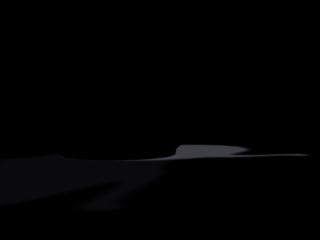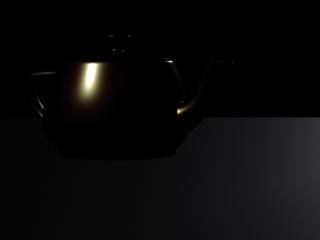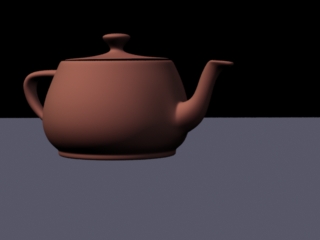Prev |
Next
To get started, let's open the Maya scene, outputs.ma.
(Where are the tutorial files?)
Render the Maya scene, outputs.ma,
with RenderMan.
Render-> Render Current Frame
You should get an image like the
one below:

The final image
The rendering above is the final image, a combination of many
different effects and surface qualities: diffuse coloring, specularity,
reflections, etc. Sometimes it is advantageous to render these various
qualities into their own image, as secondary passes. RenderMan allows you to
render secondary passes at the same time the final image is rendered,
allowing the final image to be output with a collection of secondary passes
simultaneously. Secondary passes such as specularity, reflections, shadows,
occlusion, etc., can be composited together after the fact, when specific
elements of an image (like specularity) can be tweaked without having to
render the whole image again. In this tutorial we'll go through the workflow
of setting up secondary outputs with RenderMan for Maya.
|
2 —
ADDING A SECONDARY OUTPUT |
First, we'll add a secondary output for the shadows, which
will output the shadows into their own image file. To do this, follow these
instructions:
1) Open the RenderMan Globals and select the Passes
tab.
2) Locate the Output subtab of the Passes tab.
3) Open the pull-down menu (which looks like a downward arrow) next to the Output
field and select:
Create
Ouput-> DiffuseDirectShadow
That's it. You have now created a secondary output for a
shadow. Whenever the final image is rendered, a secondary output for the shadow
will be created at the same time. When this is accomplished, simply render again.
As before you should get the same final image:

The final image
But now you'll also have the shadow output. This image is
automatically stored in your current Maya project and is located in the RenderMan
folder, under the name of the maya file. In this case the secondary output for
the shadow can be found here:
RenderMan/outputs/images/outputs_DiffuseDirectShadow.iff

RenderMan Studio users that are rendering to 'it' can see the
secondary outputs via the Catalog view, with the images cascaded below each
primary output.
The secondary output for the image looks like this:

The secondary output for the shadow.
Using the same workflow, we can make secondary
outputs for specular, reflections, and diffuse values. Do that now.
1) Open the RenderMan Globals and select the Passes
tab.
2) Locate the Output subtab of the Passes tab.
3) Open the pull-down menu next to the Output field and
select:
Create
Ouput-> SpecularDirect
4) Open the pull-down menu next to the Output field and
select:
Create
Ouput-> DiffuseDirect
5) Open the pull-down menu next to the Output field and
select:
Create
Ouput-> SpecularIndirect
Now render again. In addition to the final image and the
shadow output, you'll also get the addtional secondary outputs in your
directory, RenderMan/outputs/images/

The secondary output for the specularity.

The secondary output for the diffuse.

The secondary output for the reflection.
These individual layers are now ready for compositing.
|
4 — MANAGING SECONDARY OUTPUTS |
You'll notice that the pull-down menu next to the Output field
has a list of the secondary outputs we just created. This pull-down menu can
be used to toggle back and forth between secondary outputs. When a secondary
output is selected, the parameters particular to that secondary output appear
below it. Using these parameters any secondary output can be configured. The
file format, the filter, the quantization, and more can be changed.
From this pull-down menu layers can also be deleted.
Since we are done with this exercise, delete all of the secondary outputs that
we just created:
1) Locate the Output subtab of the Passes tab
in the Render Globals.
2) Open the pull-down menu next to the Output field and
select:
Create
Output-> Delete Output

Usually secondary
outputs should be created during the final render, but in certain situations
you'll want to create secondary outputs during other pre-passes, like shadow
passes, reference passes, etc. By switching pass types (using the Pass
pull-down menu in the Passes tab) you can add secondary passes to any
individual pass that you require.
Secondary Ouputs, useful for compositing techniques, can be
created with RenderMan for Maya. RenderMan for Maya is flexible when it comes
to how these secondary outputs are created. Because the pixels for the
secondary outputs are output at the same time that the pixels for the final image
are calculated, RenderMan is very efficient when creating these outputs. In
fact, secondary outputs require minimal additional overhead.
Prev |
Next
|
Pixar Animation Studios
Copyright©
Pixar. All rights reserved.
Pixar® and RenderMan® are registered trademarks of Pixar.
All other trademarks are the properties of their respective holders. |




